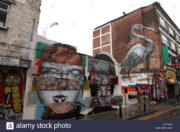Art: And what is it for?
[ I’ve been too busy with other projects — mainly, completing my current novel — to post anything new. Here, I re-post an old note that a reader just brought to my attention, from my earlier blog “Literature & Society”. To see it in its original form, click on What is art? And what’s it for? (2012.02.27 )]
Art? For what? These eternal questions kept coming up on our very artsy visit to London last week, where we took in: Hajj: journey to the heart of Islam at the British Museum; Dickens & London at the Museum of London; the play “The Pitmen Painters” at the Duchess Theatre on Drury Lane, and even a visit to ancient Stonehenge. But any preconceptions about these questions were especially challenged on the walking-tour of East London street art, under the guidance of energetic young connoisseur Gary of Alternative London Tours.
A young chap named Laurence was particularly persistent in asking himself, and me, the purpose of art, as we walked through Brick Lane and other alleys and streets of what continues to be London’s most diverse and colorful low-rent district, the notorious East End, now partly gentrified but still offering innumerable spaces — walls, doorways, cornices, lintels and window ledges — for constantly surprising and ever changing drawings, paintings and sculptures of the most heterogeneous materials. What was the purpose of the art we were looking at, and what could or should be the purpose of the novel that he was writing? As I said to him, “art” doesn’t have to have a purpose, and in fact can’t have one, but that every artist must. “Purpose” implies intention, which can be formulated only by self-conscious beings. Or another way of saying this would be, art has as many purposes as the artists who are creating it.
It was obvious that the makers of the circles of stone at Stonehenge, the weavers and painters and builders of the intricate objects and structures that have become part of the Hajj, a writer like Charles Dickens (is there any writer like Charles Dickens?), and contemporary street artists all have or had particular and dissimilar intentions. And except for the street artists and maybe Dickens, most of them seem to have been unconcerned about the esthetic function of their work. The builders of Stonehenge and the craftsmen and craftswomen of the Hajj were/are expressing devotion; their works are merely the material manifestations of prayer. They look like “art” to those of us who view them from outside the devotional ecstasy. Dickens’ intentions were mainly to entertain and to sell. The esthetic function was certainly important, but mainly for those purposes — better to sell his booklets. If he ever described his stories as “art” it must have been in the sense of skill, comparable to the craftsmanship of a bootmaker or any other artisan.
This discovery of intention is what makes the experience recounted in “The Pitmen Painters” so lively and provocative. The barely educated “pitmen” (coal miners) who gathered for classes in Ashington, Northumberland (U.K.) from 1934 to 1984 discovered “art” and their own intentionality through their own practice. Or, as the better-read Marxists among them would have said, praxis. Check out their story here, The Ashington Group. And then look at some samples (regrettably, in too-tiny images) of the Ashington Group’s pictures.
The question Laurence or I, or you or any other artist must ask, is what is my purpose? And we won’t really know until we do it.
